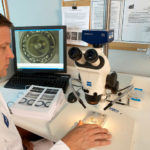When a bearing fails prematurely, an experienced bearing engineer can often times reconstruct the sequence of events leading up to the problem. Utilizing the resources of our bearing engineering laboratory, metrology lab and tool room AST engineers welcome the opportunity to analyze bearings for our customers, and in most cases have the ability to determine the root cause of a failure and recommend actions to be taken to prevent future failures.

While most analysis work is conducted after bearing failure, conducting an analysis prior to failure can help identify actual operating conditions and failure modes before key evidence is destroyed. A post-service analysis conducted on bearings that have seen extensive field service can be very informative in regards to improving product performance and ultimately reduce costs.
We prefer customers return the bearings as they were found at the time of failure, or when operation ceased. They should still be mounted in the equipment, or device, if practical. AST’s engineers can then make visual observations and determine the best method to disassemble the bearings so as not cause further damage or destroy evidence. In addition, a complete application history of the equipment and bearings should be provided. This would include loads, speeds, operating environment, and handling or use information.
AST’s engineers have been compiling data from our failure analysis for the past 25 years. The most common causes of premature bearing failure are fatigue, improper lubrication, contamination, and improper handling or installation techniques. When our engineer determines the cause of a failure, we then work with our customers to implement changes and provide a variety of solutions to increase life, or eliminate intermittent failures. Not only do we initiate design changes when appropriate, our bearing specialists also conduct training seminars for personnel handling or installing bearings.
While we have a wide array of equipment at our disposal to conduct bearing analysis, and perhaps the most valuable tool is a stereo microscope. Bearings and the components are examined at varying magnifications, between 10X and 65X. A trained eye and proper lighting is essential. The microscope is fitted with a high-resolution digital camera. This enables us to capture the images, create reports, and send information electronically.
First, we examine the external surface of the bearings for anything significant. Heavy axial scratches, or lines, on the OD or in the bore indicate interference fits. Circumferential lines on these surfaces, usually indicates slippage in the housing, or on the shaft. This generates wear debris. Ring faces are examined for damage that may be signs of mishandling or improper mounting techniques.
Before disassembling the bearing, the lubricant is closely examined. Often, only a residue remains. Grease lubricants are examined for presence of base oil, color, texture, and presence of metallic particles. In most cases, lubricant failure is observed. However, this is often the normal progression in the sequence of events in a failure, and there are other causes at the root of the problem.
Disassembling the bearings allows for examination of the individual bearing rings and raceways, the balls, and the ball separator. The raceway of the inner ring usually provides the best information because it is easier to view and the contact stresses are usually higher than those in the outer ring. The wear path or ball track is examined for its finish, width, shape and position. Examination of the ball track yields information on loading, alignment, imbalance, roundness. The raceways are also examined for damage from impact or shock loads as well damage from debris or contamination.
For more information about post service bearing inspection and failure analysis contact our team of bearing experts.

